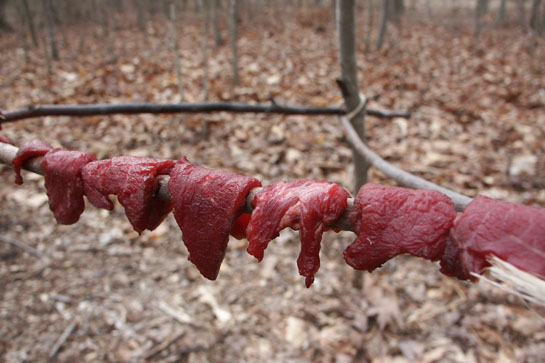Smoking meat and fish can produce some remarkably flavorful results, and it can be done without much in the way of modern conveniences. Smoking can also be used in conjunction with drying to save and preserve your meats and fish, all without the need for electricity or special equipment.
There are two traditional ways to smoke fish and other foods: hot smoking and cold smoking. Either can be performed with the same meats and the same apparatus, the only difference being the amount of heat used.
Hot Smoking
This technique involves a closed box to hold in the smoke and the heat from your smoke-producing materials. The foods are cooked by this heat, and permeated with a smoky flavor. Fish prepared in this manner can last up to a week at room temperature. Red meats, white meats, or any poultry should be eaten the same day, or the next day at the latest.
Cold Smoking
Cold smoking is done at cooler temperatures, for a longer period time. The goal in this method is long-term storage, which requires more of a drying process than a cooking process. It should not get hot enough in the smoker to actually cook the meat or fish. Temperatures under 100 degrees Fahrenheit are a must; under 80 is ideal. As with hot smoking, cold smoking can be done in a box or shed. It can also be done in open air by placing the meat or fish downwind of a smoky pile of coals. Maintain the smoking and air drying for a full day. If the meat becomes almost brittle, it is done. If conditions are humid and/or still, bring it in at night and smoke it a second day.
Smoking with Wood Chips
The heat source is important in smoking, but the woods chips are the most vital part of the operation. Modern smoking setups typically involve a pan of dampened chips sitting on a hot plate (portable electric burner). More traditional methods (i.e. without electricity) were achieved with a pan of hardwood coals from a fire and wet wood chips sprinkled over the top of them.
There are a number trees whose wood imparts a nice flavor to meat. Find out which of these are locally abundant in your area and chop up some chips with an axe or machete.
– Apple wood from a local orchard makes a great, sweet smoke perfect for poultry and pork.
– Hickory gives a rich, sharp flavor and makes for hot, long-burning coals.
– Maple wood chips are excellent for smoking cheeses.
– Mesquite, native to the southern US, is a coveted smoke producer with an earthy flavor.
– Ash makes a lightly flavored smoke that is great for fish and poultry.
– Oak wood smoke has a heavy flavor. Red oak is good on ribs and pork, while white oak turns into more long-lasting coals.
Just make sure to avoid any toxic trees. My local bad guys in the eastern U.S. are black locust, yew, buckeye, horsechestnut, rhododendron, and mountain laurel. You’ll also want to skip bitter smoking and resinous woods like cedar, cypress, redwood, fir, pine, spruce, and other needle-bearing trees.
Do you smoke your game meat and fish? Which method do you prefer? Do you have a favorite wood? Let us hear about it in the comments.
